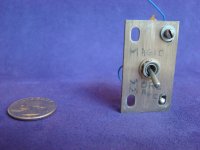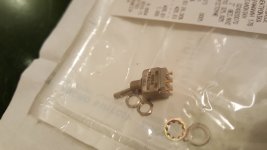Upcoming Events:
- VCF South West - June 14 - 16, Davidson-Gundy Alumni Center at University of Texas at Dallas
- VCF West - Aug 2 - 3, Computer History Museum, Mountain View, CA
- VCF Midwest - Sept 7 - 8 2024, Schaumburg, IL
- VCF SoCal - Mid February 2025, Location TBD, Southern CA
- VCF East - April 2025, Infoage Museum, Wall NJ
-
Please review our updated Terms and Rules here
You are using an out of date browser. It may not display this or other websites correctly.
You should upgrade or use an alternative browser.
You should upgrade or use an alternative browser.
Magic Switch anniversary
- Thread starter larsbrinkhoff
- Start date
DougIngraham
Veteran Member
I never heard of a "Magic Switch" before. Now I want one!
Thanks!
Thanks!
commodorejohn
Veteran Member
One of my favorite old hacker tales 
BitWiz
Experienced Member
Oh great bit deity in the ether please grant the magic switch a good life in the bit bucket and keep the magic blue smoke from escaping.
larsbrinkhoff
Member
Shades of "You are not expected to understand this."
Oh, sorry. I should have posted the background story too: http://www.catb.org/jargon/html/magic-story.html
Some years ago, I (GLS) was snooping around in the cabinets that housed the MIT AI Lab's PDP-10, and noticed a little switch glued to the frame of one cabinet. It was obviously a homebrew job, added by one of the lab's hardware hackers (no one knows who).
You don't touch an unknown switch on a computer without knowing what it does, because you might crash the computer. The switch was labeled in a most unhelpful way. It had two positions, and scrawled in pencil on the metal switch body were the words ‘magic' and ‘more magic'. The switch was in the ‘more magic' position.
I called another hacker over to look at it. He had never seen the switch before either. Closer examination revealed that the switch had only one wire running to it! The other end of the wire did disappear into the maze of wires inside the computer, but it's a basic fact of electricity that a switch can't do anything unless there are two wires connected to it. This switch had a wire connected on one side and no wire on its other side.
It was clear that this switch was someone's idea of a silly joke. Convinced by our reasoning that the switch was inoperative, we flipped it. The computer instantly crashed.
Imagine our utter astonishment. We wrote it off as coincidence, but nevertheless restored the switch to the ‘more magic’ position before reviving the computer.
A year later, I told this story to yet another hacker, David Moon as I recall. He clearly doubted my sanity, or suspected me of a supernatural belief in the power of this switch, or perhaps thought I was fooling him with a bogus saga. To prove it to him, I showed him the very switch, still glued to the cabinet frame with only one wire connected to it, still in the ‘more magic’ position. We scrutinized the switch and its lone connection, and found that the other end of the wire, though connected to the computer wiring, was connected to a ground pin. That clearly made the switch doubly useless: not only was it electrically nonoperative, but it was connected to a place that couldn't affect anything anyway. So we flipped the switch.
The computer promptly crashed.
This time we ran for Richard Greenblatt, a long-time MIT hacker, who was close at hand. He had never noticed the switch before, either. He inspected it, concluded it was useless, got some diagonal cutters and diked it out. We then revived the computer and it has run fine ever since.
We still don't know how the switch crashed the machine. There is a theory that some circuit near the ground pin was marginal, and flipping the switch changed the electrical capacitance enough to upset the circuit as millionth-of-a-second pulses went through it. But we'll never know for sure; all we can really say is that the switch was magic.
I still have that switch in my basement. Maybe I'm silly, but I usually keep it set on ‘more magic’.
larsbrinkhoff
Member
I never heard of a "Magic Switch" before. Now I want one!
The exact part number can be seen in another of GLS' photos: Honeywell 1TW1-3
I got one for myself:
Attachments
larsbrinkhoff
Member
I should have posted the background story too
I added some more information from Steele, Moon, Knight, Weinreb:
The Magic Switch · Issue #1232 · PDP-10/its
I grabbed this from http://www.catb.org/jargon/html/magic-story.html. I was thinking it should be in some ITS backup file, but I couldn't find it. Some years ago, I (GLS) was snooping around in the...
Note that some of the recollections are inconsistent between each other.
larsbrinkhoff
Member
This would have been a great easter egg to have one of the Command Module switches in "Apollo 13" labeled like this.
- Huston, we have a problem!
- Check the magic switch. Which way is it set?
- Er, it's set to "magic".
- Well duh! Set it to "more magic"!!
- Roger. That fixed the problem.
Roland Huisman
Veteran Member
It sounds a bit like electronic engineer humour. All electronic parts have special magic smoke inside. When you let the magic smoke escape, the component is dead. The process can't be reversed, you can't catch the magic smoke and put it back inside the component.
My wife's cousin, who really is a rocket scientist (NASA - Huntsville) points out that the release of the magic smoke can be accompanied by a brief pop. Engineers have used that phenomenon to create the NED or Noise Emitting Diode.It sounds a bit like electronic engineer humour. All electronic parts have special magic smoke inside. When you let the magic smoke escape, the component is dead. The process can't be reversed, you can't catch the magic smoke and put it back inside the component.
jackrubin
Veteran Member
And of course, there is the little light inside an EPROM that comes on to tell you that you've inserted it wrong-way-round in the programming socket. (I hope this is not considered age-ist humor - I assume readers of this list know that EPROMs have a window on top, just so you can see the light.)
pbirkel@gmail.com
Veteran Member
But ... only once, AFAIK. So look quick!And of course, there is the little light inside an EPROM that comes on to tell you that you've inserted it wrong-way-round in the programming socket. (I hope this is not considered age-ist humor - I assume readers of this list know that EPROMs have a window on top, just so you can see the light.)



